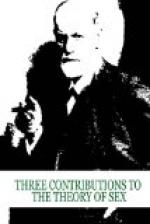Freud had learned that the amnesias of hypnosis and of hysteria were not absolute but relative and that in covering the lost memories, much more, of unexpected sort, was often found. Others, too, had gone as far as this, and stopped. But this investigator determined that nothing but the absolute impossibility of going further should make him cease from urging his patients into an inexorable scrutiny of the unconscious regions of their memories and thoughts, such as never had been made before. Every species of forgetfulness, even the forgetfulness of childhood’s years, was made to yield its hidden stores of knowledge; dreams, even though apparently absurd, were found to be interpreters of a varied class of thoughts, active, although repressed as out of harmony with the selected life of consciousness; layer after layer, new sets of motives underlying motives were laid bare, and each patient’s interest was strongly enlisted in the task of learning to know himself in order more truly and wisely to “sublimate” himself. Gradually other workers joined patiently in this laborious undertaking, which now stands, for those who have taken pains to comprehend it, as by far the most important movement in psychopathology.
It must, however, be recognized that these essays, of which Dr. Brill has given a translation that cannot but be timely, concern a subject which is not only important but unpopular. Few physicians read the works of v. Krafft-Ebing, Magnus Hirschfeld, Moll, and others of like sort. The remarkable volumes of Havelock Ellis were refused publication in his native England. The sentiments which inspired this hostile attitude towards the study of the sexual life are still active, though growing steadily less common. One may easily believe that if the facts which Freud’s truth-seeking researches forced him to recognize and to publish had not been of an unpopular sort, his rich and abundant contributions to observational psychology, to the significance of dreams, to the etiology and therapeutics of the psychoneuroses, to the interpretation of mythology, would have won for him, by universal acclaim, the same recognition among all physicians that he has received from a rapidly increasing band of followers and colleagues.
May Dr. Brill’s translation help toward this end.
There are two further points on which some comments should be made. The first is this, that those who conscientiously desire to learn all that they can from Freud’s remarkable contributions should not be content to read any one of them alone. His various publications, such as “The Selected Papers on Hysteria and Other Psychoneuroses,"[1] “The Interpretation of Dreams,"[2] “The Psychopathology of Everyday Life,"[3] “Wit and its Relation to the Unconscious,"[4] the analysis of the case of the little boy called Hans, the study of Leonardo da Vinci,[4a] and the various short essays in the four Sammlungen kleiner Schriften, not only all hang together, but supplement each other to a remarkable extent. Unless a course of study such as this is undertaken many critics may think various statements and inferences in this volume to be far fetched or find them too obscure for comprehension.




